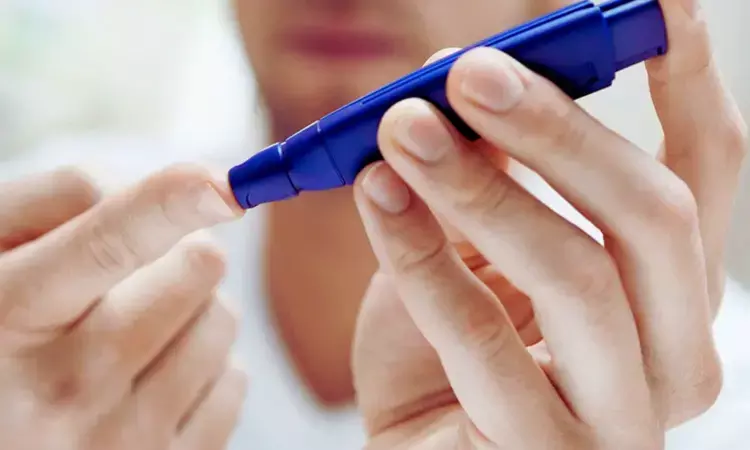- Home
- Medical news & Guidelines
- Anesthesiology
- Cardiology and CTVS
- Critical Care
- Dentistry
- Dermatology
- Diabetes and Endocrinology
- ENT
- Gastroenterology
- Medicine
- Nephrology
- Neurology
- Obstretics-Gynaecology
- Oncology
- Ophthalmology
- Orthopaedics
- Pediatrics-Neonatology
- Psychiatry
- Pulmonology
- Radiology
- Surgery
- Urology
- Laboratory Medicine
- Diet
- Nursing
- Paramedical
- Physiotherapy
- Health news
- Fact Check
- Bone Health Fact Check
- Brain Health Fact Check
- Cancer Related Fact Check
- Child Care Fact Check
- Dental and oral health fact check
- Diabetes and metabolic health fact check
- Diet and Nutrition Fact Check
- Eye and ENT Care Fact Check
- Fitness fact check
- Gut health fact check
- Heart health fact check
- Kidney health fact check
- Medical education fact check
- Men's health fact check
- Respiratory fact check
- Skin and hair care fact check
- Vaccine and Immunization fact check
- Women's health fact check
- AYUSH
- State News
- Andaman and Nicobar Islands
- Andhra Pradesh
- Arunachal Pradesh
- Assam
- Bihar
- Chandigarh
- Chattisgarh
- Dadra and Nagar Haveli
- Daman and Diu
- Delhi
- Goa
- Gujarat
- Haryana
- Himachal Pradesh
- Jammu & Kashmir
- Jharkhand
- Karnataka
- Kerala
- Ladakh
- Lakshadweep
- Madhya Pradesh
- Maharashtra
- Manipur
- Meghalaya
- Mizoram
- Nagaland
- Odisha
- Puducherry
- Punjab
- Rajasthan
- Sikkim
- Tamil Nadu
- Telangana
- Tripura
- Uttar Pradesh
- Uttrakhand
- West Bengal
- Medical Education
- Industry
Young-Onset Diabetes Tied to Beta Cell Deficiency, Not Obesity: PHENOEINDY-2 Study

India: A recent study published in Diabetologia has shed light on a unique presentation of type 2 diabetes among young adults in Assam, India-one that defies the conventional link between diabetes and obesity.
Conducted by Dr. Anupam Dutta and colleagues from the Department of Medicine, Assam Medical College and Hospital, Dibrugarh, the PHENOEINDY-2 study highlights a concerning prevalence of non-autoimmune diabetes among undernourished individuals, with beta cell dysfunction emerging as the primary driver.
The study involved 240 GADA-negative young adults (diagnosed with type 2 diabetes before the age of 40) and 252 non-diabetic individuals from similar socio-economic backgrounds as controls. Notably, both groups shared a median BMI of 23 kg/m². Many participants came from economically disadvantaged tea garden communities, a setting that offered critical insights into the interplay between poverty, malnutrition, and metabolic disorders.
The key findings of the study were as follows:
- 53% of young diabetic patients and 61% of control participants exhibited elevated body fat levels despite having a normal BMI, indicating a prevalent "thin–fat" phenotype.
- The "thin–fat" body composition was characterized by relatively high abdominal fat despite a lean outward appearance.
- Over two-thirds of the diabetic patients had a BMI below 25 kg/m², and 14% were underweight (BMI <18.5 kg/m²).
- Stunted growth was observed in 28% of the diabetic individuals.
- 27% of the diabetic participants were anaemic, pointing toward chronic undernutrition.
- Compared to non-Hispanic white Americans in the NHANES study, both Assamese diabetic and non-diabetic participants showed higher waist-to-hip ratios, body roundness indices, and truncal fat content, reinforcing the presence of the "thin–fat" phenotype.
- The metabolic profile of these patients differed from the typical Western pattern of obesity-driven diabetes.
- Patients showed marked beta-cell dysfunction with a median HOMA-B score of 25.7.
- Insulin resistance was only mild among the patients, with a median HOMA-S score of 103.
- Underweight individuals had the most severe hyperglycemia, significant beta-cell deficiency but remained insulin-sensitive.
Further classification revealed that around two-thirds of the participants with diabetes belonged to the "severely insulin-deficient diabetes" (SIDD) subgroup based on the Swedish classification system. These findings point toward beta cell deficiency, rather than insulin resistance, as the primary abnormality in this population.
The authors suggest that multigenerational undernutrition may play a crucial role in the development of diabetes in this setting. The study underscores the need to broaden the understanding of diabetes phenotypes in low- and middle-income countries and tailor interventions accordingly.
"The PHENOEINDY-2 study calls attention to the heterogeneity of young-onset type 2 diabetes in India. In regions like Assam, where undernutrition remains a persistent issue, the conventional obesity-linked model of diabetes may not apply. Instead, chronic nutritional deprivation and associated beta-cell impairment appear to be at the heart of the disease's development," the authors concluded.
Reference:
Dutta, A., Dutta, P.K., Baruah, S.M. et al. Non-autoimmune diabetes in young people from Assam, India: the PHENOEINDY-2 study. Diabetologia (2025). https://doi.org/10.1007/s00125-025-06500-9
Dr Kamal Kant Kohli-MBBS, DTCD- a chest specialist with more than 30 years of practice and a flair for writing clinical articles, Dr Kamal Kant Kohli joined Medical Dialogues as a Chief Editor of Medical News. Besides writing articles, as an editor, he proofreads and verifies all the medical content published on Medical Dialogues including those coming from journals, studies,medical conferences,guidelines etc. Email: drkohli@medicaldialogues.in. Contact no. 011-43720751


